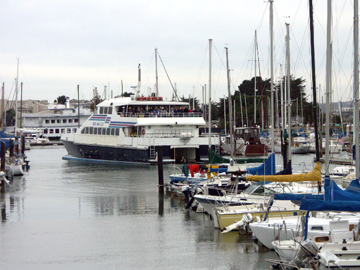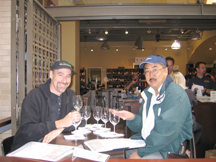The Water Transit Agency is heralding ferry services to come by hosting a series of demonstration rides free to the community. Last month it was Berkeley’s turn and a grand time was had by all.

Published: October, 2004
September 18, 2004, was the perfect overcast Saturday morning to stay in bed — but the grey weather didn’t deter more than 200 enthusiastic Berkeley and Albany residents from turning out to ride the specially chartered ferry from Berkeley to San Francisco. Berkeley has not had working passenger ferry service since 1989, immediately following the Loma Prieta earthquake and collapse of the Bay Bridge. Prior to this, Berkeley residents enjoyed traveling by ferry for nearly 100 years, before the Bay and Golden Gate Bridges were built.
Internationally known musician Country Joe McDonald, a Berkeley resident and ferry supporter, serenaded waiting passengers with his guitar and song at the Berkeley Marina, one of several proposed terminal locations along the Berkeley and Albany shoreline. Once aboard, they hardly had time to enjoy the views, including the gridlocked traffic on the Bay Bridge, during a zippy 30-minute ride to the newly restored San Francisco Ferry Building and Farmer’s Market. The San Francisco Bay Area Water Transit Authority (WTA), the event organizers, dispensed goodie bags to passengers that included chocolates donated by Scharffen Berger Chocolates, a Berkeley-based company located in the new Ferry Building.
Jeri Holan, Captain of the advocacy group Friends of the Albany Ferry, said, “After Vallejo, the Berkeley ferry route has the potential to be the largest route on the Bay. Berkeley residents want to protect the environment—it really doesn’t get much greener—this is the place where we can come up with the best system possible that will get people out of their cars—especially solo drivers— and onto the ferry.”
Grassroots Beginnings of the Berkeley Ferry
Before the WTA appeared on the scene, Linda Perry, Berkeley Commissioner and founder of the Friends of the Berkeley Ferry, worked alongside Ms. Holan drumming up grassroots support for Berkeley ferry service. “Before the WTA we were just struggling in the wilderness,” she said. “There was a lot of strong support in the community for rebuilding the ferry system, but little hope for funding. Then the WTA secured funding to make this a reality.”
Berkeley and Albany Politicians Show Their Support
Assembly member Loni Hancock remembers riding the ferry frequently after the 1989 earthquake and was sorry to see it go. “It is the best way, intellectually and spiritually, to start the day,” she said. “I am very enthusiastic about helping to realize the full potential of ferries in the Bay Area.”
Berkeley Mayor Tom Bates’ active involvement in the planning process makes this possibility look even brighter. “The city of Berkeley is looking forward to establishing regular service to and from San Francisco,” he said. “Ferries are a wonderful mode of transportation and we are hoping to implement this route as soon as possible.”
Allan Maris, Albany City Council member, WTA Community Advisory Committee member and avid bicyclist, said, “Ferries are an easy and attractive way for people to visit the waterfront—something they might not otherwise do.” He added, “There are less restrictions for taking bikes on the ferry than there are on BART.”
A New Twist on an Old Idea
For some passengers, the ride conjured up memories of an earlier era and nostalgia for the old Berkeley to San Francisco route. Albany Councilmember Jewel Okawachi grew up in Albany and remembers her father, who worked as a dentist in the city, taking the ferry from Berkeley to San Francisco every day. “I think that reviving this route is a great idea and that it, if provided with the right kinds of [public transit] connections, could attract a lot of seniors in addition to the commuter crowd,” she said
New Berkeley ferry service would help alleviate increasing congestion on 1-80 and BART, and would provide a transit alternative for Emeryville and other neighboring communities. A Berkeley ferry could also connect bikers with the Bay Trail and bring tourists to Eastshore State Park.
“I loved the ride,” said Country Joe McDonald. “If this route becomes a reality, I would actually come to San Francisco for fun—something I never do anymore because I hate having to get on the freeway.”
What’s on the Horizon?
Regional Measure 2 (RM 2), recently approved by Bay Area voters, will help to make the Berkeley to San Francisco service a reality by 2010 by allocating $12 million to help fund two new vessels and an additional $3.2 million to support annual operating costs. The next step in planning: Berkeley’s Waterfront and Transportation Commissions are organizing two meetings to provide additional information and will solicit public comment.
There are many details to resolve before Berkeley ferry service can become truly viable. These include picking a terminal location, completing a detailed environmental impact report (EIR) and improving and expanding public transit landside connections.
Mrs. Perry said, “The average person supports ferries, but there is clearly a lot more that is needed to make this route happen. It’s not an easy process, but it’s certainly possible.”



